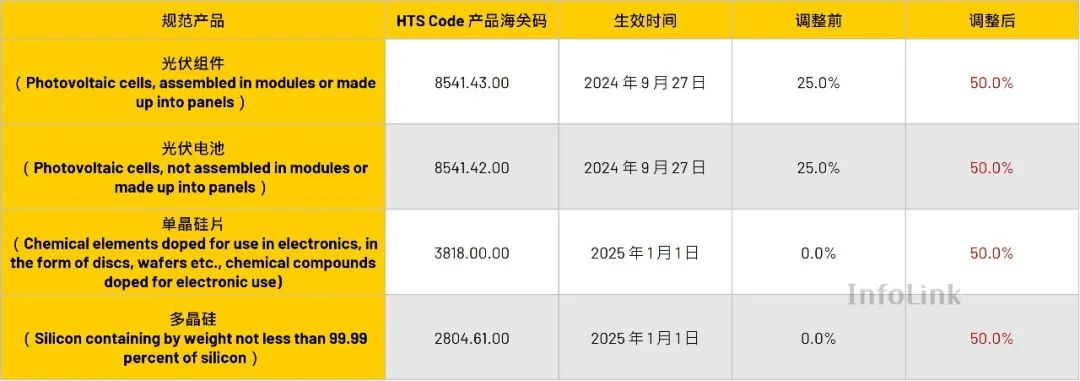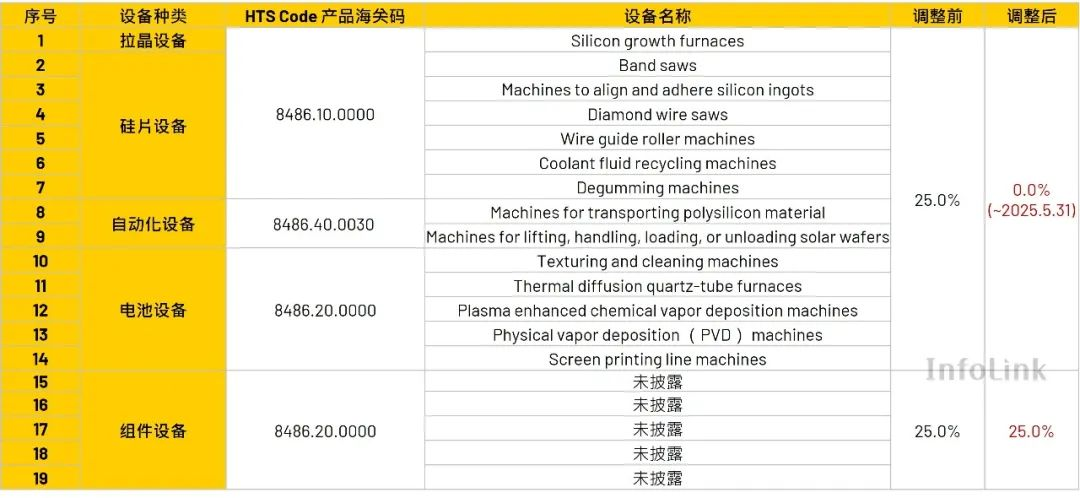Background: Under Section 301 of the Trade Act of 1974, the U.S. began imposing tariffs on Chinese imports in 2018 due to issues related to technology transfer and intellectual property. A statutory four-year review of these tariffs began in 2022 and was completed by the U.S. Trade Representative Office (USTR) in 2024, which made adjustments to certain products according to the President's directives.
Content of this Executive Order
1. Photovoltaic (PV) Products from China: Silicon, Wafers, Cells, and Modules
On September 13, 2024, the U.S. government announced an adjustment to the Section 301 tariffs on Chinese photovoltaic products. The tariffs on PV cells and modules remained the same as the administrative review results released in May, increasing from 25% to 50%, but the implementation date was pushed from August 1 to September 27. Notably, the new regulations now include polysilicon and monocrystalline silicon wafers from China, with a tariff rate of 50%, set to begin on January 1, 2025.

(Photovoltaic (PV) Products from China)
2. Photovoltaic Equipment from China
On September 12, 2024, the USTR released a Section 301 tariff exemption list for photovoltaic equipment, effective from January 1, 2024, to May 31, 2025. Out of 19 exemption applications, 14 were approved, and 5 were rejected, focusing on PV module manufacturing equipment. The approved exemptions primarily cover equipment used in the crystal pulling and wafer production stages, as well as PV cell manufacturing, aiming to boost U.S. domestic production and reduce dependence on Chinese equipment. The decision to reject five exemption applications for module manufacturing equipment was due to sufficient alternative sources within the U.S. and Europe.

(Photovoltaic Equipment from China)
Impact Analysis of the 301 Tariff Adjustment from InfoLink:
1. Impact on PV Cell and Module Tariffs
Before the tariff increase, the U.S. had already imposed several trade barriers on Chinese PV products. In addition to the original 25% Section 301 tariffs, Chinese cells and modules have faced anti-dumping duties since 2012 and Section 201 tariffs on all imports. As a result, direct imports of Chinese cells and modules to the U.S. have significantly declined. InfoLink predicts that the increase to 50% will have minimal impact on the market.
2. Impact on Polysilicon Tariffs
The U.S. still faces a shortage of domestic silicon wafer production capacity, with no significant need for imported polysilicon at present. Current plans to expand U.S. wafer production capacity amount to 10.3 GW, but the highly challenging and long production cycles make it difficult for this capacity to be realized in the short term. Therefore, the new polysilicon tariffs are expected to have a noticeable impact only after 2026.
3. Impact on Wafer Tariffs
By 2025, U.S. battery production capacity is expected to reach only about 10-11 GW, and given the lack of domestic wafer capacity, U.S. manufacturers will still need to rely on imported wafers. The new tariff may prompt a shift in U.S. wafer imports from China to Southeast Asia, where there is 39 GW of wafer capacity as of September 2024. Following the U.S.'s anti-dumping investigation into four Southeast Asian countries (Cambodia, Malaysia, Thailand, and Vietnam) in May 2024, these countries have reduced production rates, which could leave Southeast Asia well-positioned to meet U.S. demand for wafers in 2025.
Overall, given the trade barriers on Chinese cells and modules and the lack of significant domestic wafer and cell production capacity in the U.S., these tariff adjustments are expected to have a limited short-term impact. The full effects of the Section 301 tariffs will likely become more pronounced in the medium to long term, particularly from 2025 to 2026 as U.S. domestic production scales up.
4. Impact on Equipment Tariffs
The tariff exemptions mainly target equipment used in crystal pulling, wafer production, and PV cell manufacturing. This reflects the U.S. government's desire to promote domestic production capabilities while reducing reliance on Chinese equipment. However, the rejection of the five exemption applications for module manufacturing equipment underscores the U.S.'s commitment to strengthening domestic production.
This strategy of balancing tariff exemptions demonstrates U.S. support for its local PV industry while considering the needs of its supply chain. While the short-term relief for upstream equipment is notable, the continued tariff pressure on downstream manufacturing, particularly for modules, highlights the U.S.'s flexible yet assertive response to market dynamics.
In conclusion, while key equipment for wafers and cells has been granted Section 301 tariff exemptions from the start of 2024 until mid-2025, for companies considering expanding production in the U.S., the 25% tariff reduction is only one factor. Stability in policy, negotiations with state governments, and local manufacturing support are critical considerations for expansion decisions. As the U.S. supply chain improves, further adjustments to the exemption policy may occur in response to market demands.
 online service
online service +86 (0592)5663849
+86 (0592)5663849 sales@uisolar.com
sales@uisolar.com solar-mount.au
solar-mount.au